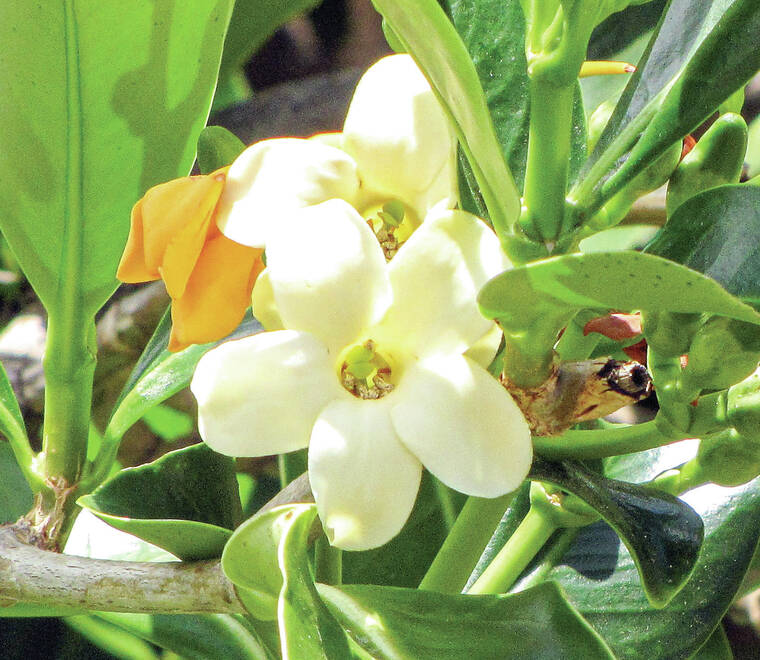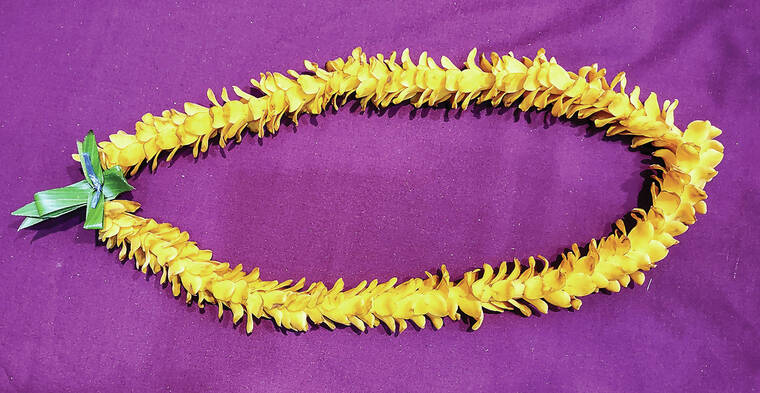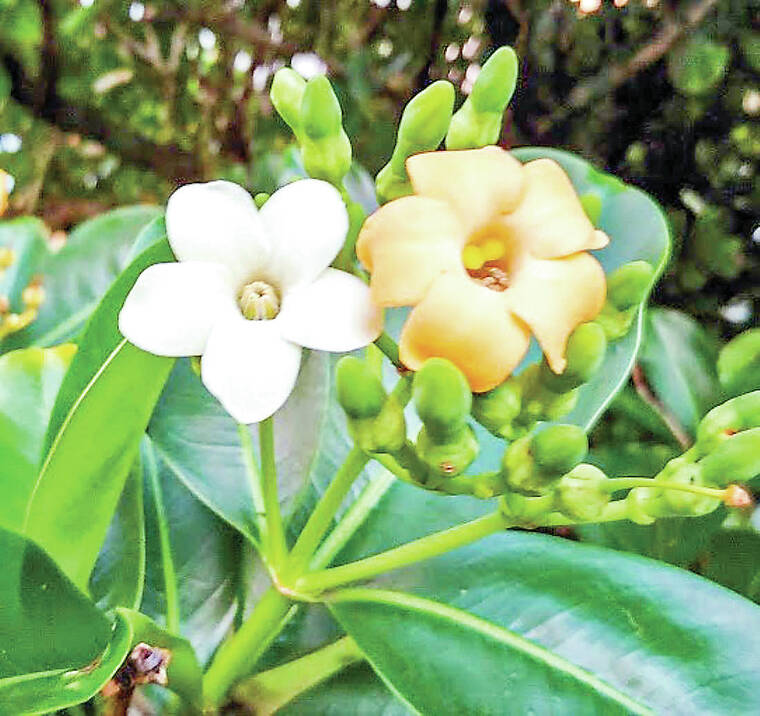Plant of the Month for April 2024: Pua Kenikeni

The delicate flowers of the pua kenikeni have a wonderful strong fragrance. (Kim and Forest Starr/Courtesy photo)

The delicate pua kenikeni lei usually only lasts for a single day. (Diana Duff/Special to West Hawaii Today)

The two-inch blossoms of the standard pua kenikeni tree change color from white to light orange during their several days on the tree. (Diana Duff/Special to West Hawaii Today)
Seeing lots of beautiful pua kenikeni lei in Hilo for Merrie Monarch, is encouragement to grow my own. You too might want to consider growing this lovely, delicate and very fragrant flower in your garden.
Seeing lots of beautiful pua kenikeni lei in Hilo for Merrie Monarch, is encouragement to grow my own. You too might want to consider growing this lovely, delicate and very fragrant flower in your garden.
The Hawaiian name of this flower is based on the flower’s value just after its introduction to Oahu in early 1900. It was known as the ten-cent flower meaning each pua sold for a dime. A pua kenikeni lei at the time sold for around five dollars, but today they are hard to find at less than four times that price.
Known botanically as Fagraea berteroana, the perfume flower tree, pua kenikeni is native to the South Pacific and Southeast Asia. Botanists have moved it to the Gentianaceae family, but it was formerly classified as a member of the Loganiaceae or strychnine family. Its former classification hints at the toxicity of the plant’s parts. Despite the flower’s delicious fragrance and its tasty looking fruit, no parts of the plant should be consumed
The heady aroma of pua kenikeni flowers defies description. At first the scent is strong, with tropical floral overtones. As you continue to inhale its heavenly perfume, a delicate sweetness unfolds with many subtle side notes. Words cannot convey the beauty of the scent. You need to smell it for yourself.
Though it has not been used to make perfume commercially, pua kenikeni has been infused in coconut oil by the Polynesians for centuries to apply to their skin.
The beautiful flower and its scent is not all that recommends this attractive plant for a West Hawaii garden. The small tree has an attractive spreading shape and lovely thick, glossy green leaves. The tree grows best in full sun in a location where the soil is rich in organic matter and is kept a bit moist but drains well. These trees can withstand short periods of drought and occasional strong winds once established and can grow more than thirty feet tall in ideal conditions. Often, they are pruned for a desired shape or to lower the height for better access to the flowers.
Some trees bloom nearly year-round putting out flower clusters at the tip of each branch in warm, humid, sunny locations. The 5-petalled, tubular flowers bloom a creamy white and turn to yellow and light orange during the few days they remain on the tree.
The pua kenikeni flower’s waxy appearance belies their delicacy. They are easily bruised from handling and make beautiful but short lived lei. Following flowering a red-orange fruit forms containing the seeds. Though birds do eat the fruit and spread the seeds, the plant has not become invasive.
Pua kenikeni grows best at elevations over 1,000 feet where the rain is more frequent and the soil a bit more acid. The can also be successfully grown in full sun at lower elevations with regular irrigation and frequent mulching, The trees prefer a rich well-drained soil.
It is best to only lightly fertilize this or other flowering plants. Too much nitrogen can produce leafy growth spurts that can limit flowering. Pua kenikeni flowers appear on new growth and will be more plentiful if the tree is pruned occasionally. Decreasing watering can also help flower production as a bit of water stress seems to stimulate flowering. Removing the fruit from the trees also encourages more flowers to form.
For information on making pua kenikeni lei check out the UH CTAHR publication “Growing Plants for Hawaiian Lei” which is available in many libraries or can be purchased though UH CTAHR online.
Though the fruit contains seeds, trees grown from seed may not flower for the first five years. The preferred propagation technique is air layering which is a soil-less way to create a new plant on the mother plant. Locate a healthy tree and select a branch to air layer now and remove in about three months. Check air layering instructions online if you want to try this technique. A detailed description of the process can also be found in “Traditional Trees of Pacific Islands” edited by Craig Elevitch.
Pua kenikeni has a moderate growth rate and may need occasional pruning for shaping or to lower branches for flower-picking ease. If you are growing it for the flowers, consider planting several in a group, keeping them low for easy access to the blossoms. It is best to plant them about fifteen feet apart to allow space for their spreading growth habit.
Though pua kenikeni is susceptible to some diseases and pests including fungal root rot and root knot nematode, healthy soil conditions with good soil drainage can help the plant resist problems. Occasional scale, mealy bugs, aphids or thrips can also be avoided with good cultural practices. Severe infestations can be treated with a combination of insecticidal soap and neem oil applied directly to the insects on the infested leaves. Apply late in the day and wash off early in the morning so the sun doesn’t burn the leaves.
Several pua kenikeni varieties are available in the nursery trade locally. You can often find a cultivar in with large flowers and another with flowers measuring nearly 5 inches long (compared to the standard 2- inch flowers). Despite the beauty of the large flowered cultivars, the smaller flower has a more potent fragrance. If you have trouble finding a plant, call Margo from Sunrise Nursery at 808-640-9191 to help.
For more information on pua kenikeni, go to “Traditional Trees of Pacific Islands” edited by Craig Elevitch and “A Tropical Garden Flora” by George Staples and Derral Herbst.
Gardening events
Saturdays: “Work Day at Amy Greenwell Garden” from 9 a.m. to 12:30 p.m. Meet at the Garden Visitor Center across from the Manago Hotel in Captain Cook. Come with a mask and prepared to practice social distancing. Volunteers can help with garden maintenance and are invited to bring a brown bag lunch. Water and snacks provided. Visit the website www.amygreenwell.garden/get-involved/volunteer-1/ and sign up for the weekly email for more information on work days.
Saturday, April 13: “Hilo Cacao and Chocolate Expo” from 9 a.m. to 3:30 p.m. at Hilo Hawaiian Hotel, 71 Banyan Drive in Hilo. Demos and displays open to the public. Free
Sunday, April 14: “Hilo Cacao and Chocolate Workshop” from 8:30 a.m. to 4 p.m. at Hilo Hawaiian Hotel, 71 Banyan Drive in Hilo. Information on chocolate processing. $22. Register at www.hilochocoexpo.org.
Tuesdays: “Coffee related webinars with live Q&A with the presenters” (now through April 30) starting at noon. Hosted at the Kona Extension YouTube account. Register at https://www.hawaiicoffeeed.com/coffeewebinars.html.
March-April: “Live Webinars by Hawaii Small Business Development Center” – go to Events and Workshops at hisbdc.org for more information and to register for the following. Fee $15.
April 18 – Personal Finances for Business Owners
April 24 – Analyzing Financial Statements – focus on Balance Sheet
May 8 – Analyzing Financial Statements – focus on Income Statement
Farmer direct markets
(Check websites for the latest hours and online markets)
Wednesday and Friday: Ho’oulu Farmers Market, 9 a.m. to 2 p.m., Sheraton Kona Resort at Keauhou Bay
Saturday: Keauhou Farmers Market, 8 a.m. to noon, at Keauhou Shopping Center; Kamuela Farmer’s Market, 7:30 a.m. to noon, Pukalani Stables; Waimea Town Market, 7:30 a.m. to noon, Parker School in central Waimea; Waimea Homestead Farmers Market, 7:30 a.m. to noon, Waimea middle and elementary school playground
Sunday: Pure Kona Green Market, 9 a.m. – 2 p.m., Amy Greenwell Garden in Captain Cook; Hamakua Harvest, 9 a.m. to 2 p.m., Hwy 19 and Mamane Street in Honoka‘a
Plant advice lines
Anytime: konamg@hawaii.edu
Tuesdays and Thursdays: 9 a.m. to noon at UH-CES in Kainaliu – 322-4893 or walk in
Mon., Tues. and Fri: 9 a.m. to noon at UH CE
Diana Duff is a plant adviser, educator and consultant living part time in Kailua-Kona.


